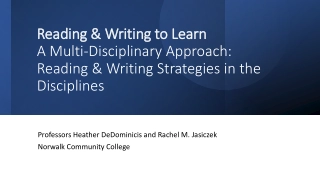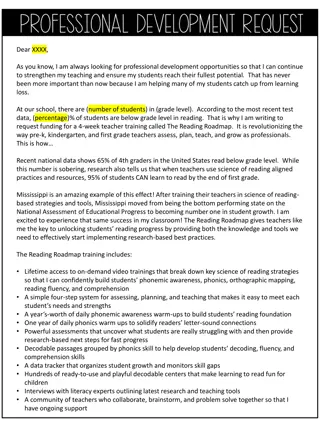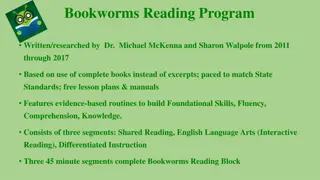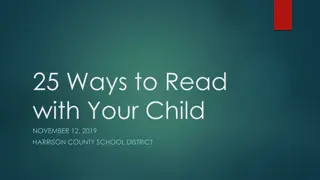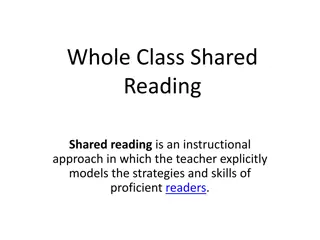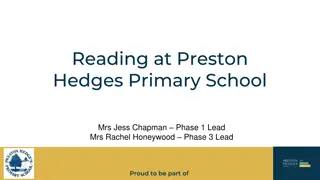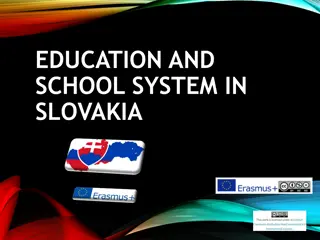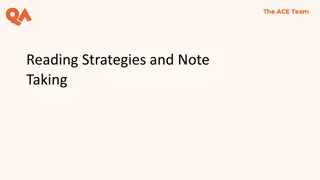Enhancing Reading Standards in Schools: A Comprehensive Approach
To tackle the reading improvement priorities, the school aims to instill a culture of reading, promote reading for pleasure, enhance fluency and comprehension, and expose children to challenging texts. Current statistics highlight the need for improvement, with a focus on lower and higher attainers, dwindling parental and pupil engagement, and the intent to deliver an engaging English curriculum. Strategies include language enrichment, non-negotiable practices, guided reading, parent engagement initiatives, and workshops. The goal is to engage all students in reading widely, develop fluency through regular reading opportunities, and create a love for reading.
Download Presentation

Please find below an Image/Link to download the presentation.
The content on the website is provided AS IS for your information and personal use only. It may not be sold, licensed, or shared on other websites without obtaining consent from the author. Download presentation by click this link. If you encounter any issues during the download, it is possible that the publisher has removed the file from their server.
E N D
Presentation Transcript
READING SCHOOL IMPROVEMENT PRIORITY: To improve standards of reading across school. Aims: 1. To embed a culture of reading across school. 2. To promote reading for pleasure. To implement further opportunity for children to improve their fluency and comprehension. 4. To implement further opportunity for children to be exposed to challenging texts. 3.
Related image Related image NATIONAL READING STATISTICS Related image England's children have less positive attitudes towards reading than in many other countries: only 26% of 10 year-olds 'like reading' compared to 46% in Portugal, 42% in Georgia, 35% in Romania, and 33% in Azerbaijan. Most children in England do not read on a daily basis: in 2011 just over a third (37%) of 10 year-olds surveyed reported reading for pleasure every day. In England, 36% of adults don't read for pleasure, rising to 44% of young people (aged 16 to 24). By the final year of compulsory schooling, the reading skills of English children from disadvantaged backgrounds are on average two and a half years behind those from the most affluent homes. Unemployed adults are twice as likely to have weak literacy skills as those in full-time employment. Related image Related image Related image
KS2 SATS What challenges do the children face in this type of questioning?
OUR CURRENT SITUATION Current data shows that these groups of children are to be prioritised: Lower attainers in KS1 Higher attainers in KS2 Monitoring also shows: A decrease in parental engagement (less children reading at home) A decrease in pupil engagement (less children reading for pleasure) English intent: To deliver an exciting, innovative English curriculum which enables and empowers children's written and oral communication and creativity.
IMPLEMENT written and oral communication and creativity. = language rich, broad vocabulary, deepened understanding- underpinned by high levels of fluency. Whole school non-negotiables (see list from previous staff meeting*): share with TAs, embed use of resources, keep records- show progress, no matter how small the steps. Guided reading, one to one reading, embed reading phases in English units, home reading incentives, reading interventions i.e. phonics catch up programmes, high quality phonics teaching and application. Parental engagement: leaflet sent home, stuck in planner, weekly incentives, resources shared (comprehension prompts, reading lists, general advice)- we all need to be communicating these messages to parents on a regular basis. Workshops this term
IMPLEMENT: READING FOR PLEASURE AIMS: 1. Engage all children in reading widely. 2. Build fluency by providing further opportunity to read regularly. 3. Provide challenge and improve levels of comprehension through further exposure to high quality, challenging texts: at home and at school.
IMPLEMENT: RIVINGTON READING AWARD SCHEME How it works: Children have a table in their Reading Journal- they use this to record the books they have read. Points system: 1 page = 1 point. Points only validated when review/ recommendation has been submitted (template provided- simplified for EYFS/KS1). FURTHER CHALLENGE: Bonus points for Let s Read titles (box of challenging, high quality non-fiction texts/ fiction texts)- sign in/out sheet for these books (books labelled): consider classic texts/ texts pitched for high ability- slightly above. Utilise texts in the library. Rewards given for points gained: Bronze, Silver, Gold, Platinum (differentiated points for different classes).
IMPLEMENT: RIVINGTON READING AWARD SCHEME Celebrated: Certificates given in Friday Get Together- written in the book- parents invited to assembly. Class display- competition element (names on trophies). All help to implement: Embed in classroom practice: in Guided Reading sessions (see example Reading Workshop Rota) Set up class room display and Let s Read boxes Regularly remind children- create buzz Send home information to parents and review/ recommendation templates- remind parents regularly e.g. parents evening, in planners etc.
MEASURING IMPACT Reading deep dives: RS/ SA + Governor walkthroughs. Talking to children/ looking at books/ talking to TAs/ teachers: are they engaged in the scheme? Do they feel it is helping them to improve their reading? Have they read texts that they ve enjoyed? Have they read texts that they found challenging? How do we prove progress for all learners? Is it evident in books? Is there progression in reading skills in English books? Do reading journals show a deepened exploration of challenging texts? Are there resources to facilitate progress- how are these having an impact? Are teachers/ TAs able to demonstrate progress through explaining records of progress? Reading ages, book band monitoring sheet, LAPs/KLIPs, test results. Record keeping will enable you to show all children are making progress (will inform conversations about progress) and will inform your teacher assessment; and will facilitate conversations about children s progress. 3 data collection points per year: tracker only.
NEXT STEPS Time scale to set up Reading Award Scheme 1 week? Reading journal sheet, Let s Read boxes, sign in/out sheet, class display. Share with TAs. RS to send information leaflet out to parents. SA to put this powerpoint and help docs on the website to support parents. Launch to children in classroom and assembly. Keep momentum: TAs to monitor when children achieve awards- pass onto class teacher for them to record in the assembly book. Repeatedly talk to children about the scheme; allow them time to share their recommendations/ reviews in class. Measure impact. Share in staff meetings.





